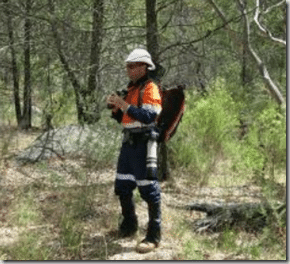Why my safety threatens the safety of wildlife
Great recent article on the Safety Differently Blog Posted by Terry Reis

Last year I saw a photo of two blokes who were conducting a fauna survey in Queensland in 1978. One is wearing a shirt with the sleeves rolled up and a pair of ‘stubbies’ (very short shorts for the more youthful and urbane among you). The other is also wearing stubbies, and nothing else other than (possibly) underwear. He is either bare-footed or in thongs. The grass makes this difficult to ascertain but he is certainly not wearing shoes or boots. Neither wears a hat and one carries a rifle and a bag slung over his shoulder. This bag may contain water, a first aid kit and other items for their safety. But I doubt it.
This photograph resonates with me as I put out my first Elliot trap as part of a fauna survey circa 1978, although I wore a shirt to cover my less-than-manly chest and didn’t carry a firearm. I continue to conduct fauna surveys, mostly when I work as a consultant and hence often for mining or coal-seam gas companies (yes, I do sleep at night). But how I long for those halcyon days of the late 70s when you could be blissfully unconcerned about your personal safety and that of your colleagues.
This is because my health and safety is now paramount in the minds, or at least procedures, of many of my employers. Apparently, nothing is of greater import to them. Before I can step forth to even glance at a bird or lunge at a lizard I must show proof that I have undergone rigorous training and seemingly endless, repetitive and largely inappropriate inductions. Strangely enough, I am seldom asked for proof that I can actually identify fauna. The details of what transpires before I venture forth into the field could be a tome in itself, but let’s just deal with the field work.
The burdens of safety
It is commonplace that I am obliged to wear a hardhat (even in treeless paddocks); high-visibility clothing (presumably so wildlife can elude me more easily); long-sleeved shirts with the sleeves buttoned at the wrist; long trousers; steel-capped boots; and safety glasses. I may be required to wear gloves, or at least have them hanging from my belt for ease and speed of deployment. I may not be allowed to carry a knife (let alone a gun), but I may have to carry a GPS (for my safety rather than recording the location of fauna), EPIRB, UHF radio, first aid kit, five kilograms of water, sunscreen, insect repellent and, albeit rarely, a defibrillator.


Do you have any thoughts? Please share them below